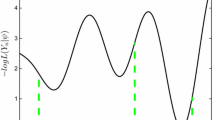Abstract
This study demonstrates that adaptive filters can be used successfully to remove noise from duplicate paleoceanographic time-series. Conventional methods for noise canceling such as fixed filters cannot be applied to paleoceanographic time-series if optimal filtering is to be achieved, because the signal-to-noise ratio is unknown and varies with time. In contrast, an adaptive filter automatically extracts information without any prior initialization of the filter parameters. Two basic adaptive filtering methods, the gradient-based stochastic least-mean-squares (LMS) algorithm and the recursive least-squares (RLS) algorithm have been modified for paleoceanographic applications. The RLS algorithm can be used for noise removal from duplicate records corrupted by stationary noise, for example, carbonate measurements, species counts, or density data. The RLS filter performance is characterized by high accuracy and fast rate of convergence. The modified LMS algorithm out-performs the RLS procedure in a nonstationary environment (e.g., stable isotope records) but at the price of a slower rate of convergence and a reduced accuracy in the final estimate. The application of both algorithms is demonstrated by means of carbonate and stable isotope data.
Similar content being viewed by others
REFERENCES
Alexander, S. T., 1986, Adaptive signal processing: theory and applications: Springer, New York, 179 p.
Bard, E., Arnold, M., Duprat, J., Moyes, J., and Dublessy, J.-C., 1987, Reconstruction of the last deglaciation: deconvolved records of δ18O profiles, micropaleontological variations and accelerator mass spectrometric 14C dating: Clim. Dyn., v. 1, p. 102–112.
Broecker, W. S., Andree, M., Wolfli, W., Oeschger, H., Bonani, G., Kennett, J., and Peteet, D., 1988, The chronology of the last deglaciation: implications to the cause of the Younger Dryas event: Paleoceanography, v. 31,no. 1, p. 1–19.
Cowan, C. F. N., and Grant, P. M., 1985, Adaptive filters: Prentice Hall, Englewood Cliffs, NJ, 308 p.
Hattingh, M., 1988, A new data adaptive filtering program to remove noise from geophysical time-or space series data: Computers & Geosciences, v. 14,no. 4, p. 467–480.
Haykin, S., 1991, Adaptive filter theory: Prentice Hall, Englewood Cliffs, NJ, 854 p.
Jansen, E., and Veum, T., 1990, Evidence for two-step deglaciation and its impact on North Atlantic deep-water circulation: Nature, v. 343, p. 612–616.
Jung, S. J. A., 1996, Wassermassenaustausch zwischen NE-Atlantik und Nordmeer während der letzten 300.000/80.000 Jahre im Abbild stabiler O-und C-Isotope: Berichte aus dem Sonderforschungsbereich 313 der Universität Kiel, v. 61, 104 p.
Kalman, R., and Bucy, R., 1961, New results in linear filtering and prediction theory: ASME Tans., Ser. D, Jour. Basic Eng., v. 83, p. 95–107.
Maslin, M. A., Shackleton, N. J., and Pflaumann, U., 1995, Surface water temperature, salinity and density changes in the northeast Atlantic during the last 45,000 years: Heinrich events, deep water formation, and climatic rebounds: Paleoceanography, v. 10,no. 3, p. 527–544.
Pflaumann, U., Duprat, J., Pujol, C., and Labeyrie, L. D., 1996, SIMMAX, a modern analog technique to deduce Atlantik sea surface temperatures from planktonic foraminifera in deep-sea sediments: Paleoceanography, v. 11,no. 1, p. 15–35.
Sarnthein, M., Erlenkeuser, H., von Grafenstein, R., and Schröder, C., 1984, Stable-isotope stratigraphy for the last 750.000 years: “Meteor” core 13519 from the eastern equatorial Atlantic: “Meteor” Forschungsergebnisse, C, v. 38, p. 9–24.
Schiffelbein, P., 1985, Extracting the benthic impulse response function: a constrained deconvolution technique: Marine Geology, v. 64, p. 313–336.
Schiffelbein, P., and Hills, S., 1984, Direct assessment of stable isotope variability in planktonic foraminifera populations: Palaeogeogr. Palaeoclimatol. Palaeoecol., v. 48, p. 197–213.
Schulz, H., 1995, Meeresoberflächentemperaturen vor 10.000 Jahren—Auswirkungen des frühholozänenen Insolationsmaximum: Berichte—Reports, Geologisch-Paläontologisches Institut der Universität Kiel, v. 73, 119 p.
Sirocko, F., 1994, Abrupt change in monsoonal climate: evidence from the geochemical composition of Arabian Sea sediments: unpublished habilitation dissertation, Universität Kiel, 216 p.
Trauth, M. H., 1995, Bioturbate Signalverzerrung hochauflösender paläoozeanographischer Zeitreihen: Berichte—Reports, Geologisch-Paläontologisches Institut der Universität Kiel, v. 74, 167 p.
Trauth, M. H., Sarnthein, M., and Arnold, M., 1997, Bioturbational mixing depth and carbon flux at the seafloor: Paleoceanography, v. 12,no. 3, p. 517–526.
Widrow, B., and Hoff, M., Jr., 1960, Adaptive switching circuits: IRE WESCON Conv. Rev., v. 4, p. 96–104.
Widrow, B., and Stearns, S. D., 1986, Adaptive signal processing: Prentice-Hall, Englewood Cliffs, NJ, 474 p.
Widrow, B., McCool, J. M., Larimore, M. G., and Johnson, C. R., 1976, Stationary and nonstationary learning characteristics of the LMS adaptive filter: Proc. IEEE, v. 64,no. 8, p. 1151–1162.
Widrow, B., Glover, J. R., McCool, J. M., Kaunitz, J., Williams, C. S., Hearn, R. H., Zeidler, J. R., Dong, E., Goodlin, R. C., 1975, Adaptive noise cancelling: principles and applications: Proc. IEEE, v. 63,no. 12, p. 1692–1716.
Wiener, N., 1949, Extrapolation, interpolation and smoothing of stationary time series, with engineering applications: MIT Press, Cambridge, MA (reprint of an article originally issued as a classified National Defense Research Report, February 1942).
Author information
Authors and Affiliations
Rights and permissions
About this article
Cite this article
Trauth, M.H. Noise Removal from Duplicate Paleoceanographic Time-Series: The Use of Adaptive Filtering Techniques. Mathematical Geology 30, 557–574 (1998). https://doi.org/10.1023/A:1021794212312
Issue Date:
DOI: https://doi.org/10.1023/A:1021794212312




